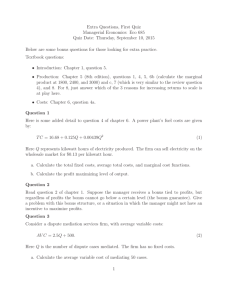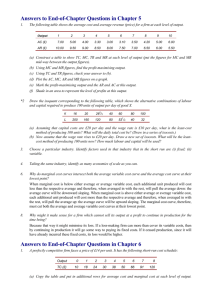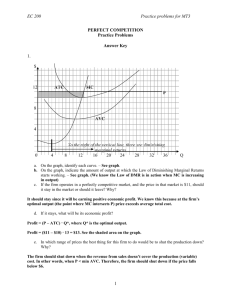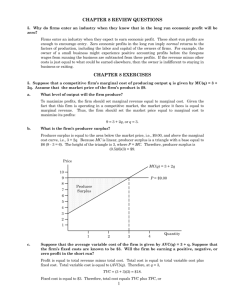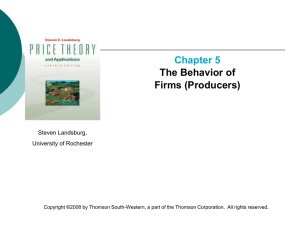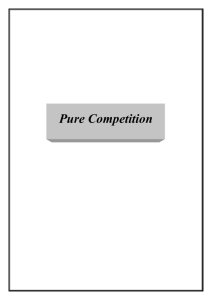Perfectly Competitive Markets
advertisement
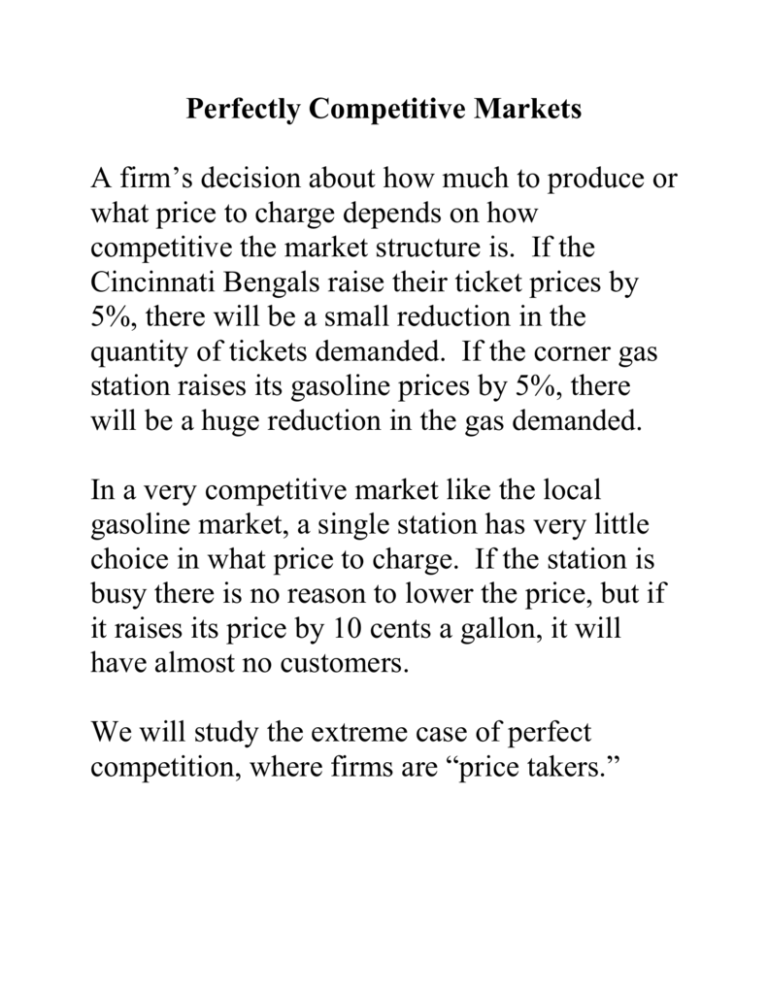
Perfectly Competitive Markets A firm’s decision about how much to produce or what price to charge depends on how competitive the market structure is. If the Cincinnati Bengals raise their ticket prices by 5%, there will be a small reduction in the quantity of tickets demanded. If the corner gas station raises its gasoline prices by 5%, there will be a huge reduction in the gas demanded. In a very competitive market like the local gasoline market, a single station has very little choice in what price to charge. If the station is busy there is no reason to lower the price, but if it raises its price by 10 cents a gallon, it will have almost no customers. We will study the extreme case of perfect competition, where firms are “price takers.” In a perfectly competitive market, (i) there are many buyers and sellers, so each buyer or seller is a price taker, (ii) all sellers supply the same, identical product. This is the model of supply and demand. If a seller could influence the price, it would not be acting according to a supply curve. In the long run, we also require that (iii) firms can freely enter or exit the market. Revenue of a Competitive Firm For a competitive firm, the price it receives does not depend on the quantity it chooses to sell. Marginal revenue equals the price of its output. For example, if the price is $6, then the total revenue of selling 10 units is $60 and the total revenue of selling 11 units is $66. Marginal revenue, ªTR/ªQ = (66-60)/(11-10) = $6. Profit Maximization Obviously, both revenue and cost considerations determine the profit maximizing output choice. But which of the cost functions is relevant? The profit maximizing output choice involves “thinking at the margin.” Consider the example given in Table 2. We can look at the profit column and see that the profit maximizing quantity is either 4 or 5. We can also compare marginal revenue (which always equals the price, $6) and marginal cost. • At outputs below 4, marginal cost is less than $6, so profits are increased by increasing output. • When output is 4, marginal cost equals marginal revenue, so increasing output does not change profits. • When output is 5 or higher, marginal cost is greater than marginal revenue, so increasing output would lower profits. The Marginal Cost Curve and the Firm’s Supply Decision • Whenever marginal revenue (price) > marginal cost, the firm increases profits by producing one more unit. • Whenever marginal revenue (price) < marginal cost, the firm increases profits by producing one less unit. • A competitive firm can only be maximizing profits when price = marginal cost. • Because the firm’s marginal cost curve determines how much the firm is willing to supply at any price, it is the competitive firm’s supply curve. • One qualification: instead of choosing the optimal production, the firm might want to shut down and produce zero. The Decision to Shut Down In the short run, a firm should shut down when P < min(AVC). This means that it is impossible for revenues per unit to be as high as variable cost per unit–it is better to avoid these variable costs. Compare profits of producing Q to the profits when the firm shuts down: B(0) = - FC B(Q) = P×Q - FC - VC Therefore, B(Q) > B(0) when P×Q > VC. Divide both sides by Q: P > AVC. If we can find a Q where P > AVC, then producing Q is better than 0. If P < min(AVC) then it is impossible to do better than shutting down. Sunk costs are costs that are already incurred and cannot be recovered. Notice that the firm’s fixed costs did not affect whether or not to shut down. Fixed costs are sunk in the short run. In the 1970's Lockhead spent $ 1 billion developing a new airplane (Tristar). After sinking the money, it was clear that the venture was not going to be a success. • Lockhead went to its creditors, and asked for more money, saying, “We have to keep going, or else the $ 1 billion will be totally wasted.” • Some of the creditors said, “Why put in more money, since there is no way we can recoup our investment?” • Who was right? • Answer: Both arguments are wrong. The billion dollar initial investment is a sunk cost that is irrelevant to the decision. Compare the extra revenue of continuing with the extra cost. “Don’t cry over spilt milk.” Another example is the question of whether to buy another ticket if you lose the one you purchased. The cost of the ticket you purchased is sunk, and therefore, irrelevant. Some fixed costs might not be sunk in the long run. For example, in the short run, you can produce zero output (shut down), but you cannot avoid your fixed capital costs. In the long run, you can sell your factory and exit the industry when profits are negative. The Firm’s Long Run Decision In the long run, a profit-maximizing firm would exit the industry if TR < TC at all output levels. Dividing by Q, the condition for exit is: P < min(ATC) Similarly, a potentially active firm should enter the industry if it can receive positive profits. Remember that opportunity cost is included, so that the firm can receive higher profits in this industry than any other industry. Enter if P > min(ATC) A perfectly competitive firm’s long run supply curve is 0 below min(ATC), and its MC curve above min(ATC). The quantity at which ATC is minimized is the quantity that maximizes the firm’s profit per unit (sometimes called profit margin). Why would the firm want to produce more than that? We can measure profits in the diagram as the area of the rectangle with width Q and height P - ATC. If the price is less than ATC, then the area of the rectangle is the firm’s losses.


